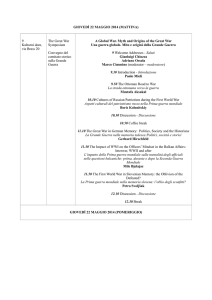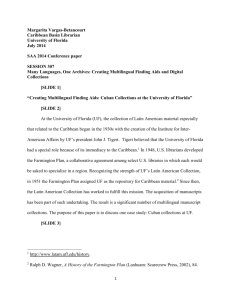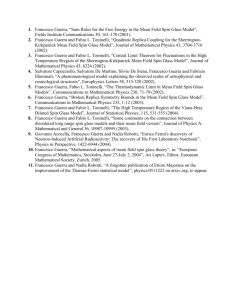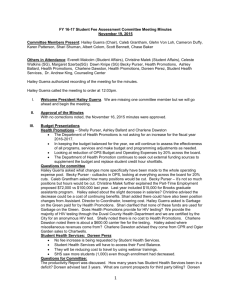SFA 2013- faculty archivists collaboration ( DOCX )
advertisement
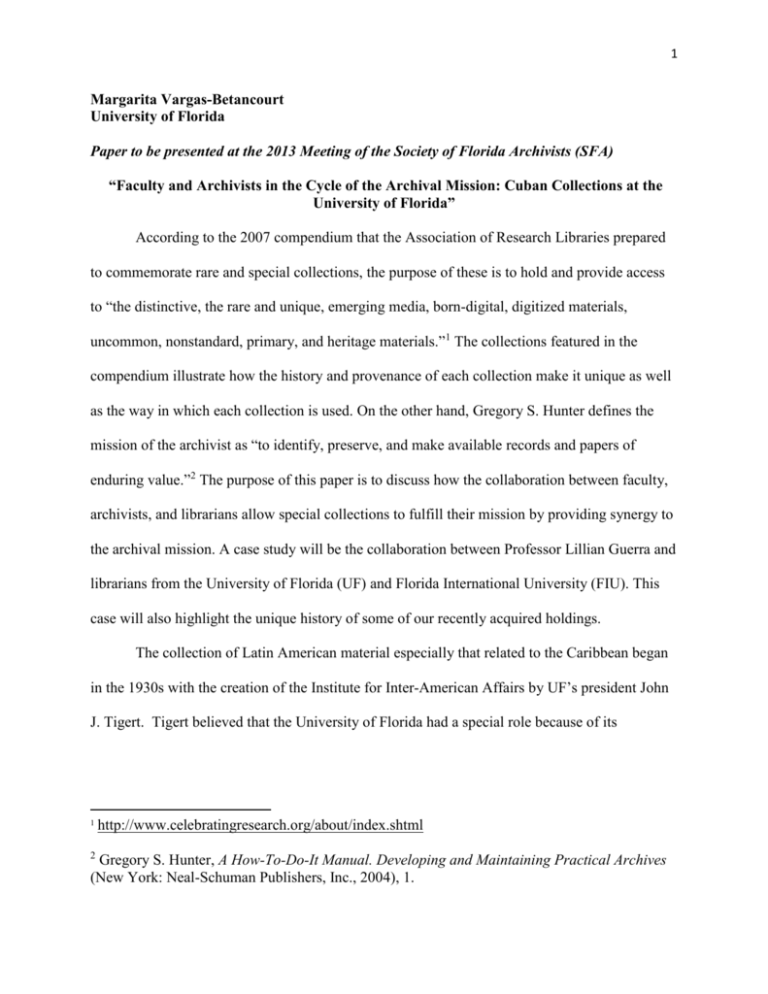
1 Margarita Vargas-Betancourt University of Florida Paper to be presented at the 2013 Meeting of the Society of Florida Archivists (SFA) “Faculty and Archivists in the Cycle of the Archival Mission: Cuban Collections at the University of Florida” According to the 2007 compendium that the Association of Research Libraries prepared to commemorate rare and special collections, the purpose of these is to hold and provide access to “the distinctive, the rare and unique, emerging media, born-digital, digitized materials, uncommon, nonstandard, primary, and heritage materials.”1 The collections featured in the compendium illustrate how the history and provenance of each collection make it unique as well as the way in which each collection is used. On the other hand, Gregory S. Hunter defines the mission of the archivist as “to identify, preserve, and make available records and papers of enduring value.”2 The purpose of this paper is to discuss how the collaboration between faculty, archivists, and librarians allow special collections to fulfill their mission by providing synergy to the archival mission. A case study will be the collaboration between Professor Lillian Guerra and librarians from the University of Florida (UF) and Florida International University (FIU). This case will also highlight the unique history of some of our recently acquired holdings. The collection of Latin American material especially that related to the Caribbean began in the 1930s with the creation of the Institute for Inter-American Affairs by UF’s president John J. Tigert. Tigert believed that the University of Florida had a special role because of its 1 2 http://www.celebratingresearch.org/about/index.shtml Gregory S. Hunter, A How-To-Do-It Manual. Developing and Maintaining Practical Archives (New York: Neal-Schuman Publishers, Inc., 2004), 1. 2 immediacy to the Caribbean.3 In 1948, U.S. librarians developed the Farmington Plan, a collaborative agreement among select U.S. libraries in which each would be asked to specialize in a specific region. Recognizing the strength of UF’s Latin American Collection, in 1951, the Farmington Plan assigned UF as the repository for Caribbean material.4 Since then, the Latin American Collection has worked to fulfill this mission. The acquisition of manuscripts has been part of this undertaking. At the same time, the Latin American Collection as part of the George A. Smathers Libraries has the mission to support the needs of the faculty, students, and the rest of the University of Florida community.5 The case discussed below shows how collaborative work between faculty and librarians allows the latter to fulfill their mission. For twenty years, Professor Lillian Guerra has taught, conducted research, and published widely on Caribbean history. In the book Visions of Power in Cuba (2012), Guerra analyzes the experience of the Cuban Revolution that different people lived. She based her quest for the relationship between citizens and the state on the memories of different individuals found in “the press, schools, churches, public culture, private letters, and artistic spheres.”6 She follows up this study in the book that she is now writing: Making Revolutionary Cuba. Like the former, this study is based on the role that collectivity played, especially urban movements, in the defeat of 3 http://www.latam.ufl.edu/history. 4 Ralph D. Wagner, A History of the Farmington Plan (Lanhuam: Scarecrow Press, 2002), 84. 5 http://www.uflib.ufl.edu/search.html?cx=002991405718492227978%3Aa3xnpi_fuq&sa=Search&cof=FORID%3A11&q=mission 6 Lillian Guerra, Visions of Power in Cuba. Revolution, Redemption, and Resistance, 1959-1971 (Chapel Hill: University of North Carolina Press, 2012), 12. 3 Fulgencio Batista. The perspective is again based on “the very human experiences” that constituted this part of Cuban history.7 Both books are based on official Cuban documents, but also on manuscripts and interviews that render “intimate personal stories.”8 One of the results of this research is the creation of rich oral history collections, some of which Guerra has donated to the University of Florida Smathers Libraries, like the Manuel Ray Oral History Collection. Ray played an important role in the Cuban Revolution and in the counterrevolutionary movements that followed it. Guerra interviewed Ray and his wife Aurora Chacón in February 2009. The significance of the interview to Ray is that it covers his activity during the 26th of July Movement as well as Ray’s alienation from Fidel Castro when the latter asked Ray to support the execution of Huber Matos in 1959.9 In addition, the interview to Chacón highlights the experience that women, especially wives of activists, had during the revolution and the counterrevolution movements.10 The collection that Guerra donated to the University of Florida includes not only the filmed interviews but also their transcription. Obtaining the donation of manuscript collections related to the Cuban Revolution not only benefitted UF’s libraries, it has also become a strategy that Guerra has used to obtain primary material for her research. In 2011, she established contact with Alejandro de la Cruz and with Frida Masdeu and started negotiating the donation of two collections. De la Cruz donated 7 Lillian Guerra, narrative for an NEH grant submitted on April 2013. 8 Guerra, Visions of Power in Cuba, 35 and Guerra, narrative for an NEH grant submitted on April 2013. 9 Huber Matos was a Protestant leader that became an important figure in the revolution against Batista. Alan West-Durán, ed., Cuba Volume 1 (Farmington Hills: GALE CENGAGE Learning, 2012), 313. 10 http://web.uflib.ufl.edu/spec/manuscript/guides/ray.htm 4 his grandfather’s papers: the Rafael Martínez Pupo Papers Relating to Comandos Mambises. As stated in the finding aid for this collection, Martínez Pupo “was a successful business man in Cuba who lost all of his enterprises and belongings when Fidel Castro nationalized private property in 1959.”11 After going into exile, Martínez Pupo organized a sabotage group, the Comandos Mambises, whose target was Cuban infrastructure. The collection documents the activities of this group. The story of Masdeu’s donation constitutes a paper of its own because it highlights the importance of archives as repositories of family historic heritages. In 2009, Frida Masdeu heard on NPR an interview with Professor Lillian Guerra. Masdeu was so impressed with the interview that she wrote down Guerra’s name, googled her, and emailed her. Masdeu told Guerra that she had in her possession the letters that her father Carlos González Blanco wrote to Masdeu and her mother while he was a political prisoner in Cuba. Masdeu and Guerra then started communicating and befriending each other. At the time, Masdeu was suffering from extreme depression and she was considering suicide, but even then she knew she wanted to find a suitable repository for her letters. Upon establishing contact with Guerra and understanding the importance of her legacy, Masdeu began to recover.12 Later, Masdeu contacted Guerra with another political prisoner, Reina Peñate de Tito who, in turn, donated the memoirs she had written on her experience.13 In the case of the three gifts described above, I followed up the contacts that Guerra established and I processed the donation and the resulting collections: the 11 12 13 http://web.uflib.ufl.edu/spec/manuscript/guides/pupo.htm Email from Frida Masdeu to the author, April 29, 2013. http://web.uflib.ufl.edu/spec/manuscript/guides/penatedetito.htm and http://web.uflib.ufl.edu/spec/manuscript/guides/gonzalezblanco.htm 5 Rafael Martínez Pupo Papers Relating to Comandos Mambises, the Carlos González Blanco Collection, and the Reina Peñate de Tito Collection. Undoubtedly, the donation of these collections supported Guerra’s research, but it also provided future researchers fair access to an important part of Cuban history, that related to the Cuban Revolution and the counterrevolutionary movements that followed it. Because of its controversial nature, this specific topic had been missing from our rich Caribbean collections. If Guerra had consulted these documents in a private way, she would not have served the history profession as much as she did by initiating these donations. Now multiple researchers can analyze the same materials and provide different perspectives on this topic. As stated above, De la Cruz and Masdeu felt very happy about the opportunity to preserve their family’s heritage and honored to collaborate with the mission of the libraries and of the university. Guerra’s expertise in Cuban history has not only helped with the process of appraisal and donation but also with the purchase of important collections, such as that of Ernesto Chávez. Chávez was one of the first generation of volunteer teachers who taught in the Cuban hinterlands during the initial years of the Cuban Revolution. The University of Florida has already purchased the first portion of this collection which includes correspondence, photos, a filmed interview of him that Guerra conducted, and its transcription. The second part of the collection is in the process of being acquired. It includes publications of the clandestine press, materials from the New York and New Jersey branches of the 26th of July Movement, manifestoes from the Cuban Communist Party, and photographs of the political and social scene in the province of Matanzas during the 1950s. These documents belonged to Chávez’s sister who in turn was a member of Cuba’s Communist Party. 6 The collaboration between faculty and archivists exemplified in this case has not been limited to the acquisition of new materials, it has also extended to the enhancement of existing collections. In 2008, Nancy Macaulay donated the collection of her late husband Professor Neill Macaulay to the University of Florida. Neill Macaulay was an emeritus professor of Latin American history. Before attending graduate school, Neill Macaulay joined the 26th of July Movement in Cuba. Although at first the gift included some material on this period of Neill Macaulay’s life, it did not include the photographs that Neill Macaulay had taken when he went to the sierra.14 Guerra discovered the existence of these photos after going over some of the CDs that Nancy Macaulay gave to us. Guerra, then, contacted Nancy and negotiated the donation of these photographs as well as the opportunity to interview her. In the summer of 2012, Guerra, Chris Woolley, a history graduate student, and I went to Nancy Macaulay’s home on two occasions. There Guerra conducted an interview that Woolley and I filmed. Nancy showed us Neill Macaulay’s 26th of July uniform, and while we were there she remembered the letters that Macaulay sent to her in 1958 and 1959 while he fought in Cuba, which were still in her possession. She donated these letters to the Libraries. Although the Neill Macaulay Collection was rich at first, the interview and the further donation of material enriched it even further. In addition, Guerra’s active participation in the pursuit for new collections has also resulted in expert guidance in the creation of finding aids. Before and after the acquisition of each of the collections that Guerra has negotiated, she has explained to me the provenance and significance of each collection. Finally, but not least, Guerra has included UF’s libraries in the collaborative agreements that she negotiated with two Cuban institutions: the Fundación Núñez Jiménez and the Biblioteca 14 Neill Macaulay, A Rebel in Cuba: an American’s Memoir (Micanopy: Wacahoota Press, 1999). 7 Nacional José Martí. These agreements allow librarians to obtain the visa that the Cuban government requires for people to enter the country and to have access to cultural institutions. More importantly, they set a framework to exchange information and material with the Fundación and the Biblioteca Nacional, especially in the form of digital collections to upload in the Digital Library of the Caribbean (dLOC). In December 2012, librarians Brooke Wooldridge (FIU), Laurie Taylor (UF), and I went with Professor Guerra to Cuba. There we gave a presentation to select Cuban scholars and librarians at the Fundación Núñez Jiménez where we highlighted the collections and the work of the Digital Library of the Caribbean. During that trip, we also met with Dr. Eduardo Torres Cuevas, director of the Biblioteca Nacional which became a partner of dLOC in 2011. As a gift, we presented to them a digital version of the Romero Family Papers Regarding José Martí, which includes a letter to María Mantilla, supposed daughter of José Martí, with a plan and design of the national library that would be built in Cuba to commemorate Martí. This gift was prepared upon Guerra’s suggestion. In turn, Torres Cuevas provided digital material to be included in the Digital Library of the Caribbean. The process of collaboration between Guerra, UF’s Latin American Collection, and the Digital Library of the Caribbean is far from over. In an NEH grant that Guerra submitted on April 2013, she promised to donate to dLOC the digital records that constitute the research for her next book: Making Revolutionary Cuba.15 I hope that the case illustrated in this paper brings forward the need of collaboration between faculty, archivists, and librarians in order to preserve and provide access to the unique and rare materials that constitute our cultural heritage and our history. This is especially 15 Lillian Guerra, narrative for an NEH grant submitted on April 2013. 8 important today as libraries and academic departments move towards digital platforms. On April 25, 2013, the Center for Latin American Studies at the University of Florida had a retreat in which this need was discussed. However, in this same meeting faculty expressed surprise at the fact that librarians wanted to work with faculty towards that goal. Constant and open communication is then needed to make such collaboration the norm and not the exception.
